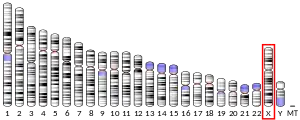SPANXB1
SPANX family member B1 is a protein that in humans is encoded by the SPANXB1 gene. [3]
| SPANXB1 | |||||||||||||||||||||||||
|---|---|---|---|---|---|---|---|---|---|---|---|---|---|---|---|---|---|---|---|---|---|---|---|---|---|
| Identifiers | |||||||||||||||||||||||||
| Aliases | SPANXB1, B1, CT11.2, SPANX-B, SPANXB, SPANXB2, SPANXF1, SPANXF2, SPANX family member B1 | ||||||||||||||||||||||||
| External IDs | OMIM: 300669 HomoloGene: 88477 GeneCards: SPANXB1 | ||||||||||||||||||||||||
| |||||||||||||||||||||||||
| |||||||||||||||||||||||||
| Orthologs | |||||||||||||||||||||||||
| Species | Human | Mouse | |||||||||||||||||||||||
| Entrez |
| ||||||||||||||||||||||||
| Ensembl |
| ||||||||||||||||||||||||
| UniProt |
| ||||||||||||||||||||||||
| RefSeq (mRNA) |
| ||||||||||||||||||||||||
| RefSeq (protein) |
| ||||||||||||||||||||||||
| Location (UCSC) | Chr X: 141 – 141 Mb | n/a | |||||||||||||||||||||||
| PubMed search | [2] | n/a | |||||||||||||||||||||||
| Wikidata | |||||||||||||||||||||||||
| |||||||||||||||||||||||||
Function
Temporally regulated transcription and translation of several testis-specific genes is required to initiate the series of molecular and morphological changes in the male germ cell lineage necessary for the formation of mature spermatozoa. This gene is a member of the SPANX family of cancer/testis-associated genes, which are located in a cluster on chromosome X. The SPANX genes encode deferentially expressed testis-specific proteins that localize to various subcellular compartments. This particular family member contains an additional 18 nucleotides in its coding region compared to the other family members in the same gene cluster. This family member is also subject to gene copy number variation. Although the protein encoded by this gene contains consensus nuclear localization signals, the major site for subcellular localization of expressed protein is in the cytoplasmic droplets of ejaculated spermatozoa. This protein provides a biochemical marker for studying the unique structures in spermatozoa, while attempting to further define its role in spermatogenesis. [provided by RefSeq, Apr 2014].
References
- GRCh38: Ensembl release 89: ENSG00000227234 - Ensembl, May 2017
- "Human PubMed Reference:". National Center for Biotechnology Information, U.S. National Library of Medicine.
- "Entrez Gene: SPANX family member B1". Retrieved 2018-07-10.
Further reading
- Wang Z, Zhang Y, Liu H, Salati E, Chiriva-Internati M, Lim SH (February 2003). "Gene expression and immunologic consequence of SPAN-Xb in myeloma and other hematologic malignancies". Blood. 101 (3): 955–60. doi:10.1182/blood-2002-06-1930. PMID 12393489.
- Hansen MA, Nielsen JE, Retelska D, Larsen N, Leffers H (February 2008). "A shared promoter region suggests a common ancestor for the human VCX/Y, SPANX, and CSAG gene families and the murine CYPT family". Mol. Reprod. Dev. 75 (2): 219–29. doi:10.1002/mrd.20651. PMID 17342728.
- Salemi M, Bosco P, Calì F, Calogero AE, Soma PF, Galia A, Lanzafame M, Romano C, Vicari E, Grasso G, Siragò P, Rappazzo G (August 2008). "SPANX-B and SPANX-C (Xq27 region) gene dosage analysis in Sicilian patients with melanoma". Melanoma Res. 18 (4): 295–9. doi:10.1097/CMR.0b013e32830aaa90. PMID 18626316.
- Salemi M, Bosco P, Calì F, Calogero AE, Soma PF, Galia A, Lanzafame M, Romano C, Vicari E, Grasso G, Siragò P, Rappazzo G (August 2008). "SPANX-B and SPANX-C (Xq27 region) gene dosage analysis in Sicilian patients with melanoma". Melanoma Res. 18 (4): 295–9. doi:10.1097/CMR.0b013e32830aaa90. PMID 18626316.
- Salemi M, Romano C, Barone C, Calí F, Caraci F, Romano C, Scavuzzo C, Scillato F, Salluzzo MG, Piccione M, Martines M, Corsello G, Nicoletti F, Bosco P (April 2009). "SPANX-B and SPANX-C (Xq27 region) gene dosage analysis in Down's syndrome subjects with undescended testes". J. Genet. 88 (1): 93–7. PMID 19417550.
- Hansen S, Eichler EE, Fullerton SM, Carrell D (February 2010). "SPANX gene variation in fertile and infertile males". Syst Biol Reprod Med. 55: 18–26. doi:10.3109/19396360903312015. PMID 20073942.
- Hansen S, Eichler EE, Fullerton SM, Carrell D (February 2010). "SPANX gene variation in fertile and infertile males". Syst Biol Reprod Med. 55: 18–26. doi:10.3109/19396360903312015. PMID 20073942.
This article incorporates text from the United States National Library of Medicine, which is in the public domain.

